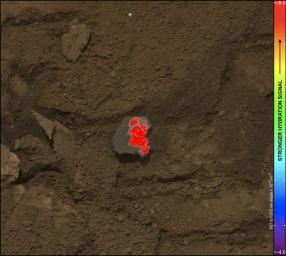
|
Hydration Map, Based on Mastcam Spectra, for broken rock ‘Tintina’
- Click the image above for a larger view
- Full-Res JPEG (1344 x 1200) (204.3 kB)
- Full-Res TIFF (1344 x 1200) (4.8 MB)
Caption:
On this image of the broken rock called "Tintina," color coding maps the amount of mineral hydration indicated by a ratio of near-infrared reflectance intensities measured by the Mast Camera (Mastcam) on NASA's Mars rover Curiosity. The color scale on the right shows the assignment of colors for relative strength of the calculated signal for hydration. The map shows a strong signal for hydration is associated with the surface that was exposed when the rock was broken by the rover driving over it.
That freshly exposed surface displays a bright material that may be the same as similarly bright material filling pale veins in the nearby bedrock of the "Yellowknife Bay" area. The size of the rock is roughly 1.2 inches by 1.6 inches (3 centimeters by 4 centimeters).
This image is a Mastcam observation of Tintina during the 160th Martian day, or sol, of the rover's work on Mars (Jan. 17, 2013). The spectral data for assessing hydration come from Mastcam observations through a series of narrow-waveband filters on Sol 162 (Jan. 19, 2013).
Background Info:
Curiosity's Mastcam was built and is operated by Malin Space Science Systems, San Diego.
NASA's Jet Propulsion Laboratory, Pasadena, Calif., manages the Mars Science Laboratory Project and the mission's Curiosity rover for NASA's Science Mission Directorate in Washington. The rover was designed and assembled at JPL, a division of the California Institute of Technology in Pasadena.
More information about Curiosity is online at http://www.nasa.gov/msl and http://mars.jpl.nasa.gov/msl/ .
Cataloging Keywords:
| Name | Value | Additional Values |
|---|---|---|
| Target | Mars | |
| System | ||
| Target Type | Planet | |
| Mission | Mars Science Laboratory (MSL) | |
| Instrument Host | Curiosity Rover | |
| Host Type | Rover | |
| Instrument | Mast Camera (MastCam) | |
| Detector | ||
| Extra Keywords | Color, Infrared, Map | |
| Acquisition Date | ||
| Release Date | 2013-03-18 | |
| Date in Caption | 2013-01-17 | 2013-01-19 |
| Image Credit | NASA/JPL-Caltech/MSSS/ASU | |
| Source | photojournal.jpl.nasa.gov/catalog/PIA16796 | |
| Identifier | PIA16796 | |
